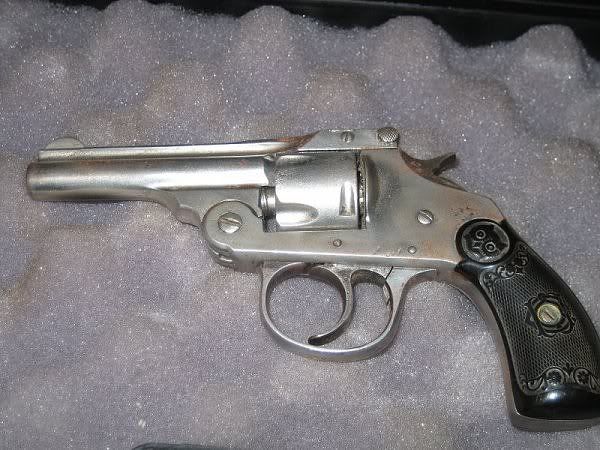Driftwood Johnson
New member
Howdy
I am not aware of any single book that is going to be just about 32 caliber revolvers. If you are interested in S&W revolvers, the best book on the market is the Standard Catalog of Smith and Wesson by Supica and Nahas. This is book is a survey of everything S&W has made from 1857 until the present. I have the 3rd edition, which was published in 2006, so it ends there. I just ordered the brand-spanky new 4th edition which just came out a few months ago, so it should be current right up to now. There is one other book I can recommend, Smith & Wesson, 1857-1945 by Neal and Jinks. This book goes into much more detail about each model, than SCSW. But for a first book, the SCSW is recognized as a great source to start to get familiar with everything S&W has ever made. In it you will find information about all the 32 caliber revolvers they made.
With the success of SCSW a few years ago, there have been 'Standard Catalogs' published about most of the major gun manufactures recently. None of them lives up to the level of SCSW, but they are not too bad. I use my Standard Catalog of Colt Firearms by Rick Sapp almost as much as I do my SCSW. If you want to know more about cartridges, Cartridges of the World by Frank C Barnes is always a good place to start.
OK, let's talk about 32 caliber cartridges. The following photo does not show every 32 caliber cartridge ever made, but it shows one of each from my cartridge collection. Left to right they are 32 Rimfire Short, 32 Rimfire Long, 32 Short Colt, 32 S&W, 32 S&W Long, 32 Colt New Police, and 32-20. Sorry, I do not have any 32 H&R cartridges and 327 Magnum is much too new a cartridge to be in my collection. Also missing from my collection is 32 Long Colt. An editorial comment here. There is no such thing as the 32 S&W Short cartridge. It is simply the 32 S&W, period. When the later, longer cartridge was introduced, it became known as the 32 S&W Long. More about that later.
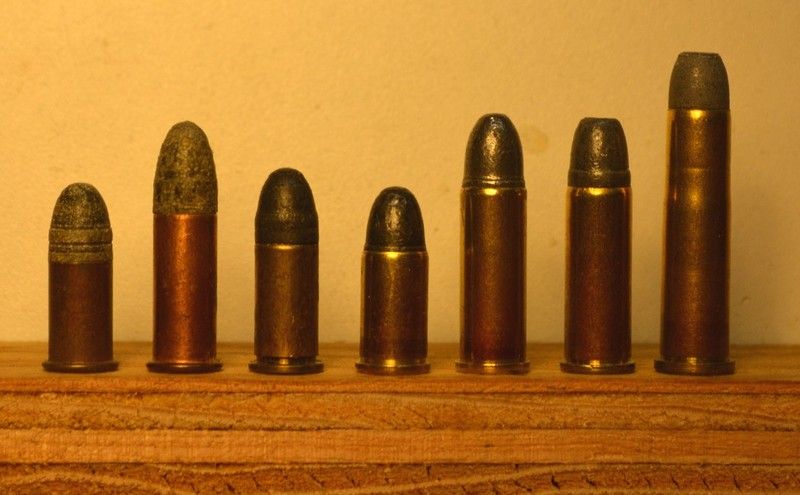
OK, let's talk about 32 caliber revolvers a little bit. Again, these are only what I have in my collection, there are many others, but these are a good starting point. Here are four old Smith and Wesson 32 caliber revolvers. The two on the left are called Tip Ups and the two on the right are Top Breaks. Tip Ups were the first revolvers S&W made, starting in 1857. The first one was a tiny little 22 caliber revolver. The Tip Ups were designated by frame sizes, #1, #1 1/2, and #2. They are called Tip Ups because to reload you release the catch at the bottom of the barrel, and rotate the barrel up. The barrel rotates around the screw you can see at the top of the frame. The two Tip Ups in this photo are both 32 caliber, they fired the 32 Rimfire cartridges on the left in the photo above. The small one is a five shot # 1 1/2 Tip Up that was made in 1873. The larger one is a 6 shot #2, also known as the Old Army model that was made in 1863. The Old Army is the largest and most powerful Tip Up that S&W ever made. They experimented with a 44 caliber design, but the Mechanism was not strong enough for 44 caliber. The Old Army model was bought by many Northern troops in the Civil War.
Top Breaks differ from Tip Ups because the barrel rotates down in a Top Break. It rotates around the pivot screw visible in the frame. They are called Top Breaks because they 'break' at the top of the frame. Top Breaks were more complicated guns than the Tip Ups, they featured an automatic ejector that ejected the empty shells when the gun was broken open. The Top Break at the top right of the photo is a 32 Single Action. It shipped in 1881. Notice it has a spur trigger. S&W also made double action 32 caliber Top Breaks that had a trigger guard, but I do not have one in my collection.
The revolver at the bottom right of the photo is called a 32 Safety Hammerless. It shipped in 1905. These were double action only revolvers, the hammer is hidden inside the frame. They were sometimes called Lemon Squeezers because of the grip safety at the rear of the grip. The Safety Hammerless revolvers were made in both 32 and 38 caliber.
Now, notice how much shorter the cylinders are on the Top Breaks than on the Tip Ups. That is because the Tip Ups fired either the 32 Rimfire short or long from the cartridge photo above, while the 32 Top Breaks only fired the very short 32 S&W round. The 32 S&W round was developed in 1878 for the 32 Single Action revolver at the upper right of the photo.
All of these guns are antiques. I doubt you will be looking at a Tip Up, but you should know they are not a very strong design. The little #1 Tip Ups were designed for the 22 Short, but they should never be fired with modern 22 Short ammunition, only ammo loaded with Black Powder. The same for the 32 caliber Tip Ups, only Black Powder 32 Rimfire ammo. Of course, 32 RF ammo is not made any more. You will find plenty of shooters who feel it is OK to fire modern Smokeless ammuntion in the centerfire Top Breaks. I am not one of them. I will only fire Black Powder ammunition, which I load myself, in a Top Break.
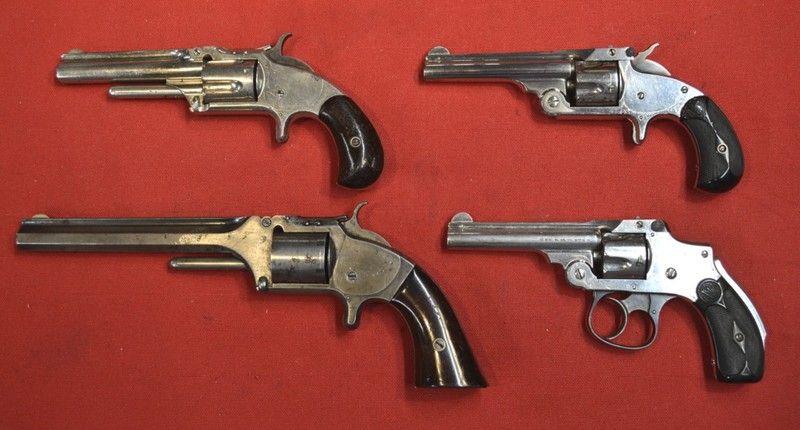
Now let's move on to more modern S&W 32 caliber revolvers with cylinders that swing out to the side. The revolver at the bottom of this photo is a 32 Hand Ejector, 1st Model. Hand Ejector simply means that unlike a Top Break, you had to eject the empties manually by pushing back the ejector rod, it was not automatic the way it was with a Top Break. The 32 HE, also known as the model 1896 was the first revolver S&W made with a side swinging cylinder. This one shipped in 1898. This is the revolver the 32 S&W Long cartridge was developed for. This is the 32 caliber round that all the S&W 32 Hand Ejectors was chambered for, except the 32-20 HE. Of course, the shorter 32 S&W round could be fired in them, just as a 38 Special can be fired in a 357 Magnum. The 32 HE 1st Model is easily recognized because of the squared off appearance of the frame near the hammer. The 32 HE 1st Model was also unique in that it had a locking mechanism that hearkened all the way back to the Tip UPs. The cylinder bolt was in the top strap, not down below the cylinder as with every other revolver S&W made after that. The 32 HE went on for many more models, the frame evolved into what is known as the I frame.
The revolver in the center of the photo is a 32 Regulation Police. It was chambered for the 32 S&W Long round. This one shipped in 1925. It is interesting to note that enough policemen were carrying this little 32 caliber revolver that S&W named the model after them. The Regulation Police model was also chambered for 38 S&W. But the I frame cylinder (about the same size as a modern J frame) could only hold five 38 caliber rounds.
The 'large' revolver at the top of the photo is a 32-20 Hand Ejector. It shipped in 1916. It is built on the K frame, the same frame the 38 M&P and Model 10 is built on today. A revolver this size was needed for the much longer 32-20 round, as can be seen in the cartridge photo. This photo gives a good idea of the relative sizes of the K frame and I frame 32 caliber revolvers.
Missing from my collection is the highly sought after K-32 or Model 16 as it became known in 1957. This was a K frame companion to the K-22 and K-38, chambered for the 32 S&W Long cartridge. They are highly sought after by collectors and so they are not cheap. They looked pretty much like the 32-20 HE at the top of the photo, but they had target sights.
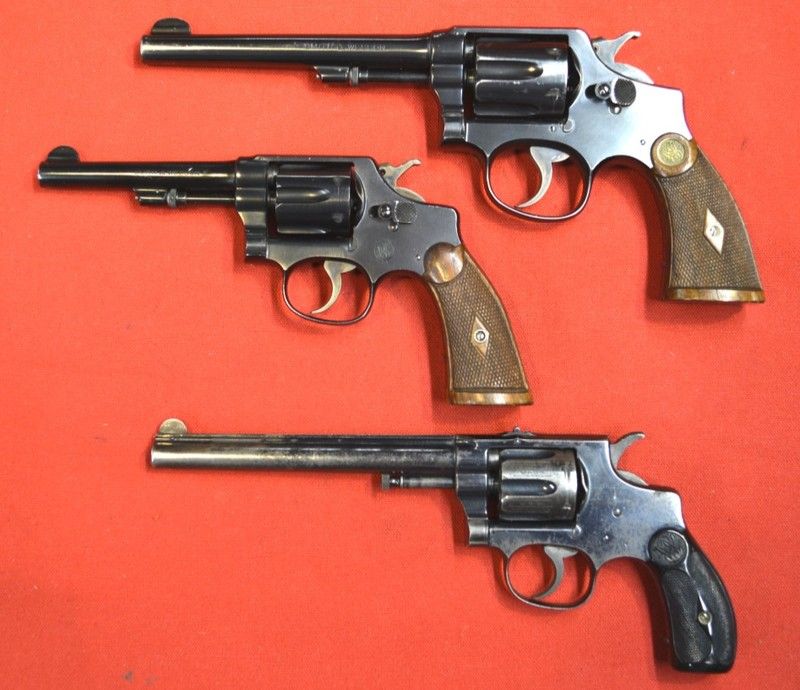
Finally, here are three 32 caliber Colts. The one at the top is a Police Positive Special chambered for 32-20. It shipped in 1926. This gun is the same size as the Police Positive Specials that were chambered for 38 Special, and has the same long cylinder required for the 32-20 round. It is slightly smaller than a K frame Smith.
Below that is a Police Positive 32, chambered for 32 Colt New Police. If you look at the cartridge photo you will see the 32 Colt New Police is basically the same as the 32 S&W Long, except it has a flat nosed bullet. This is a smaller gun than the Police Positive Special, it is roughly the same size as a S&W Regulation Police.
Finally, the little revolver at the bottom of the photo is a 32 Pocket Positive that shipped in 1908. This little gun is chambered for the 32 Long Colt cartridge. 32 Short Colt and 32 Long Colt used a heeled bullet, with the cartridge case the same diameter as the bullet. A 32 S&W or 32 S&W Long cartridge will not chamber in this revolver.
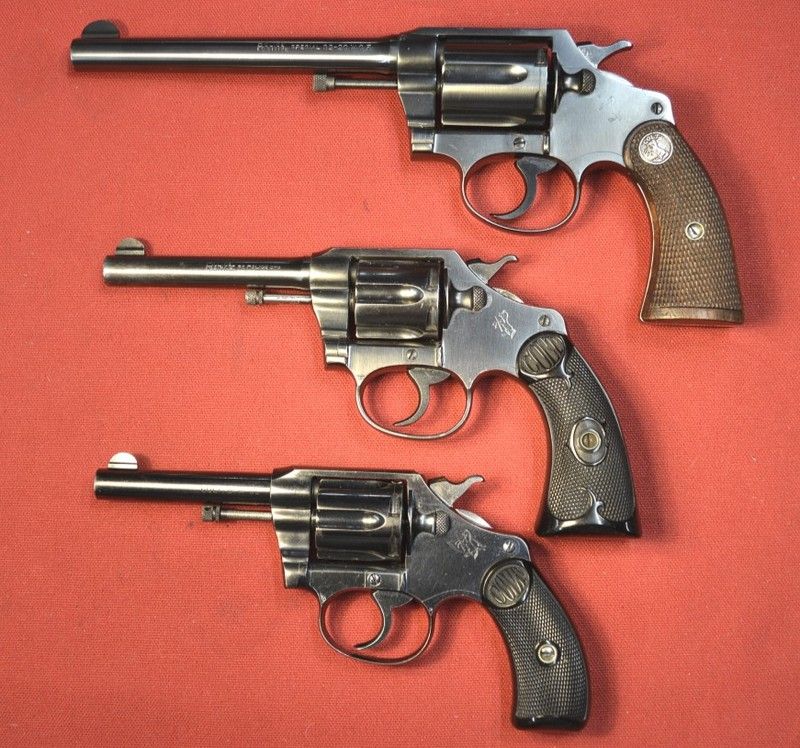
So that is a brief overview of 32 caliber S&W and Colt revolvers. Just the tip of the iceberg, so to speak. I have bought all of these in the last few years, none of them has been exorbitantly expensive, but none of them has been cheap either. They are fun to shoot, and the ammo is available and not too expensive. Be sure what caliber you are getting. Stay away from 32 Short Colt and Long Colt. For shooters, I would stay away from the Top Breaks too, unless you want to load your own ammo with Black Powder.
But that's just me.
I am not aware of any single book that is going to be just about 32 caliber revolvers. If you are interested in S&W revolvers, the best book on the market is the Standard Catalog of Smith and Wesson by Supica and Nahas. This is book is a survey of everything S&W has made from 1857 until the present. I have the 3rd edition, which was published in 2006, so it ends there. I just ordered the brand-spanky new 4th edition which just came out a few months ago, so it should be current right up to now. There is one other book I can recommend, Smith & Wesson, 1857-1945 by Neal and Jinks. This book goes into much more detail about each model, than SCSW. But for a first book, the SCSW is recognized as a great source to start to get familiar with everything S&W has ever made. In it you will find information about all the 32 caliber revolvers they made.
With the success of SCSW a few years ago, there have been 'Standard Catalogs' published about most of the major gun manufactures recently. None of them lives up to the level of SCSW, but they are not too bad. I use my Standard Catalog of Colt Firearms by Rick Sapp almost as much as I do my SCSW. If you want to know more about cartridges, Cartridges of the World by Frank C Barnes is always a good place to start.
OK, let's talk about 32 caliber cartridges. The following photo does not show every 32 caliber cartridge ever made, but it shows one of each from my cartridge collection. Left to right they are 32 Rimfire Short, 32 Rimfire Long, 32 Short Colt, 32 S&W, 32 S&W Long, 32 Colt New Police, and 32-20. Sorry, I do not have any 32 H&R cartridges and 327 Magnum is much too new a cartridge to be in my collection. Also missing from my collection is 32 Long Colt. An editorial comment here. There is no such thing as the 32 S&W Short cartridge. It is simply the 32 S&W, period. When the later, longer cartridge was introduced, it became known as the 32 S&W Long. More about that later.

OK, let's talk about 32 caliber revolvers a little bit. Again, these are only what I have in my collection, there are many others, but these are a good starting point. Here are four old Smith and Wesson 32 caliber revolvers. The two on the left are called Tip Ups and the two on the right are Top Breaks. Tip Ups were the first revolvers S&W made, starting in 1857. The first one was a tiny little 22 caliber revolver. The Tip Ups were designated by frame sizes, #1, #1 1/2, and #2. They are called Tip Ups because to reload you release the catch at the bottom of the barrel, and rotate the barrel up. The barrel rotates around the screw you can see at the top of the frame. The two Tip Ups in this photo are both 32 caliber, they fired the 32 Rimfire cartridges on the left in the photo above. The small one is a five shot # 1 1/2 Tip Up that was made in 1873. The larger one is a 6 shot #2, also known as the Old Army model that was made in 1863. The Old Army is the largest and most powerful Tip Up that S&W ever made. They experimented with a 44 caliber design, but the Mechanism was not strong enough for 44 caliber. The Old Army model was bought by many Northern troops in the Civil War.
Top Breaks differ from Tip Ups because the barrel rotates down in a Top Break. It rotates around the pivot screw visible in the frame. They are called Top Breaks because they 'break' at the top of the frame. Top Breaks were more complicated guns than the Tip Ups, they featured an automatic ejector that ejected the empty shells when the gun was broken open. The Top Break at the top right of the photo is a 32 Single Action. It shipped in 1881. Notice it has a spur trigger. S&W also made double action 32 caliber Top Breaks that had a trigger guard, but I do not have one in my collection.
The revolver at the bottom right of the photo is called a 32 Safety Hammerless. It shipped in 1905. These were double action only revolvers, the hammer is hidden inside the frame. They were sometimes called Lemon Squeezers because of the grip safety at the rear of the grip. The Safety Hammerless revolvers were made in both 32 and 38 caliber.
Now, notice how much shorter the cylinders are on the Top Breaks than on the Tip Ups. That is because the Tip Ups fired either the 32 Rimfire short or long from the cartridge photo above, while the 32 Top Breaks only fired the very short 32 S&W round. The 32 S&W round was developed in 1878 for the 32 Single Action revolver at the upper right of the photo.
All of these guns are antiques. I doubt you will be looking at a Tip Up, but you should know they are not a very strong design. The little #1 Tip Ups were designed for the 22 Short, but they should never be fired with modern 22 Short ammunition, only ammo loaded with Black Powder. The same for the 32 caliber Tip Ups, only Black Powder 32 Rimfire ammo. Of course, 32 RF ammo is not made any more. You will find plenty of shooters who feel it is OK to fire modern Smokeless ammuntion in the centerfire Top Breaks. I am not one of them. I will only fire Black Powder ammunition, which I load myself, in a Top Break.

Now let's move on to more modern S&W 32 caliber revolvers with cylinders that swing out to the side. The revolver at the bottom of this photo is a 32 Hand Ejector, 1st Model. Hand Ejector simply means that unlike a Top Break, you had to eject the empties manually by pushing back the ejector rod, it was not automatic the way it was with a Top Break. The 32 HE, also known as the model 1896 was the first revolver S&W made with a side swinging cylinder. This one shipped in 1898. This is the revolver the 32 S&W Long cartridge was developed for. This is the 32 caliber round that all the S&W 32 Hand Ejectors was chambered for, except the 32-20 HE. Of course, the shorter 32 S&W round could be fired in them, just as a 38 Special can be fired in a 357 Magnum. The 32 HE 1st Model is easily recognized because of the squared off appearance of the frame near the hammer. The 32 HE 1st Model was also unique in that it had a locking mechanism that hearkened all the way back to the Tip UPs. The cylinder bolt was in the top strap, not down below the cylinder as with every other revolver S&W made after that. The 32 HE went on for many more models, the frame evolved into what is known as the I frame.
The revolver in the center of the photo is a 32 Regulation Police. It was chambered for the 32 S&W Long round. This one shipped in 1925. It is interesting to note that enough policemen were carrying this little 32 caliber revolver that S&W named the model after them. The Regulation Police model was also chambered for 38 S&W. But the I frame cylinder (about the same size as a modern J frame) could only hold five 38 caliber rounds.
The 'large' revolver at the top of the photo is a 32-20 Hand Ejector. It shipped in 1916. It is built on the K frame, the same frame the 38 M&P and Model 10 is built on today. A revolver this size was needed for the much longer 32-20 round, as can be seen in the cartridge photo. This photo gives a good idea of the relative sizes of the K frame and I frame 32 caliber revolvers.
Missing from my collection is the highly sought after K-32 or Model 16 as it became known in 1957. This was a K frame companion to the K-22 and K-38, chambered for the 32 S&W Long cartridge. They are highly sought after by collectors and so they are not cheap. They looked pretty much like the 32-20 HE at the top of the photo, but they had target sights.

Finally, here are three 32 caliber Colts. The one at the top is a Police Positive Special chambered for 32-20. It shipped in 1926. This gun is the same size as the Police Positive Specials that were chambered for 38 Special, and has the same long cylinder required for the 32-20 round. It is slightly smaller than a K frame Smith.
Below that is a Police Positive 32, chambered for 32 Colt New Police. If you look at the cartridge photo you will see the 32 Colt New Police is basically the same as the 32 S&W Long, except it has a flat nosed bullet. This is a smaller gun than the Police Positive Special, it is roughly the same size as a S&W Regulation Police.
Finally, the little revolver at the bottom of the photo is a 32 Pocket Positive that shipped in 1908. This little gun is chambered for the 32 Long Colt cartridge. 32 Short Colt and 32 Long Colt used a heeled bullet, with the cartridge case the same diameter as the bullet. A 32 S&W or 32 S&W Long cartridge will not chamber in this revolver.

So that is a brief overview of 32 caliber S&W and Colt revolvers. Just the tip of the iceberg, so to speak. I have bought all of these in the last few years, none of them has been exorbitantly expensive, but none of them has been cheap either. They are fun to shoot, and the ammo is available and not too expensive. Be sure what caliber you are getting. Stay away from 32 Short Colt and Long Colt. For shooters, I would stay away from the Top Breaks too, unless you want to load your own ammo with Black Powder.
But that's just me.
Last edited:


